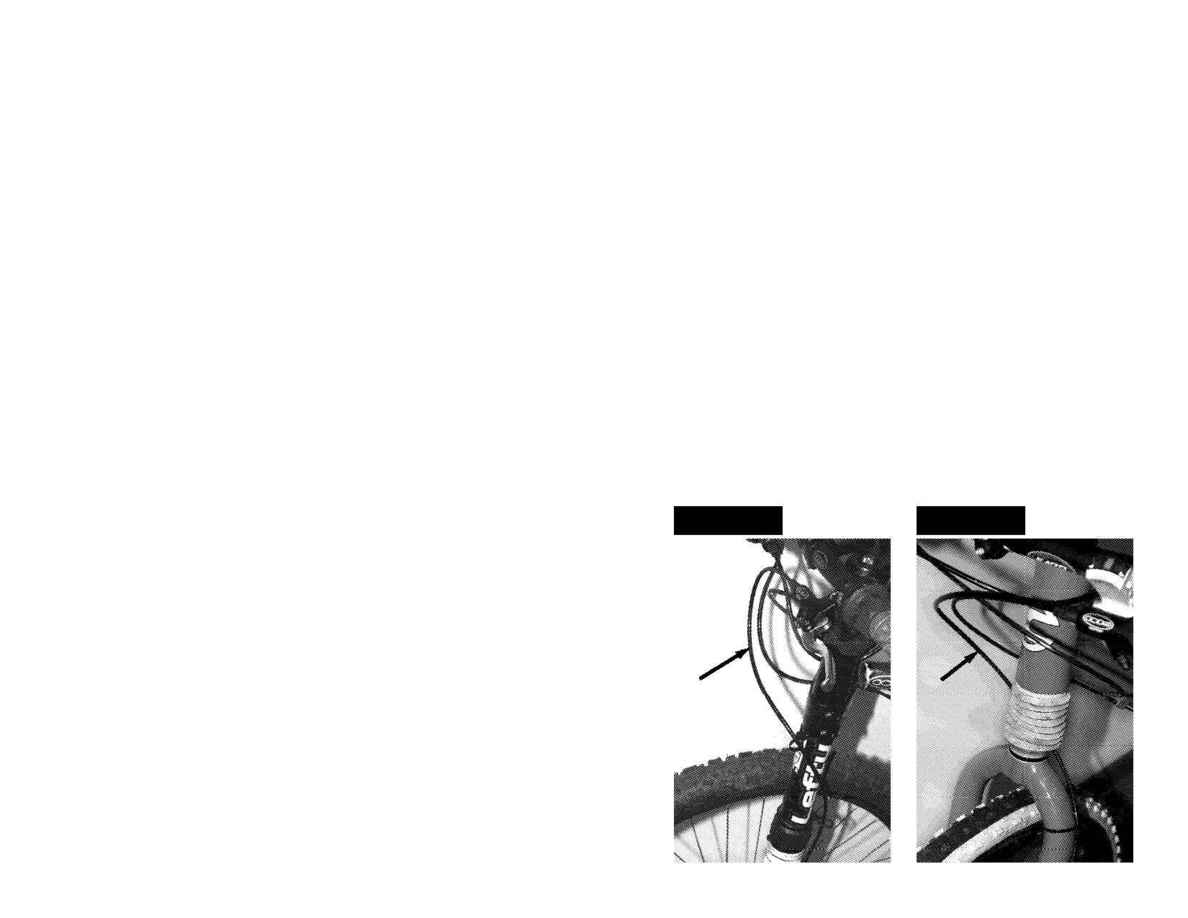
existing mounts or to clamp, weld, or in any other way add new or different mounts.
Any attempt to modify the frame, fork, or related components will void the warranty
and may weaken or damage the frame. For installation instructions and other
warnings, refer to the literature provided by the brake's manufacturer. The Scalpel is
designed to accept disc brakes that conform to the international mounting standard.
SEAT POST CLAMP BOLT
When installing or adjusting the height of the seat post, make sure that the seat post
has a light coat of good quality bicycle grease where the post fits inside the frame;
this prevents corrosion and seizing. The seat post clamp bolt should be lightly
greased and tightened to 75 In-lbs (8.5 Nm). Do not tighten the seat post clamp bolt
unless a seat post is installed in the frame.
FRONT BRAKE CABLE ROUTING
When installing derailleur cables and brake lines to your bicycle, be sure to use
lengths that will not impede steering control and will not contact wheels or tires. Run
front brake line directly from the front brake lever to the front brake. If equipped with
a Lefty, the brake line should not go through the clamps, but rather to the outside of
the Lefty leg and behind to the disc brake. See Fig. 1. If equipped with a Fatty Ultra
or Super Fatty fork, the tubing from the front brake lever should be directed behind
the shock boot and down the back of the left fork leg to the disc brake. See Fig. 2.
COMPONENT COMPATIBILITY AND PRECAUTIONS FOR
COMPONENT COMPATIBILITY AND PRECAUTIONS FOR
ALL SCALPEL MODELS
ALL SCALPEL MODELS
FORKS
The new Scalpel frame is only compatible with in-headtube type HeadShok forks
(such as the Fatty Ultra and Super Fatty) and the Lefty fork. The Scalpel frame is not
compatible with any kind of double-crown triple-clamp fork from any manufacturer. It
is not to be used with a Cannondale Moto Freeride or Moto 120 fork.
CRANKSET / BOTTOM BRACKET
Depending upon model, the Scalpel frame either uses the Cannondale Si integrated
crank and bottom bracket system, or a standard threaded 68mm wide bottom
bracket. In the case of a standard bottom bracket configuration, proper bottom
bracket spindle length depends on the crankset being used. To select the correct
bottom bracket, follow the recommendations of the crank manufacturer, providing
the proper clearance between the crank arms and the frame is maintained. In the
case of the Cannondale Si system, see the "Cannondale System Integration Crank
Owner's Manual Supplement" which should have been included with your bicycle.
Regardless of what type of crank and bottom bracket your bike uses, the Scalpel's
maximum usable chainring size is 44 teeth. Use of a larger chainring may damage
the carbon chainstays or frame. Such damage will not be covered under
Cannondale warranty.
CHAINSTAY PROTECTOR
The chainstays on your Scalpel are made of lightweight and thin carbon fiber.
Although very strong, the carbon is very susceptible to damage from a rubbing or
slapping chain. To protect the chainstays from damage, we have installed a self-
adhesive protector. This protector has been applied to the top of the right (drive side)
chainstay, below the chain. Please inspect this protector frequently. If the protector
becomes damaged, abraded, or peels off, it should be replaced immediately to
prevent damage to the chainstay. Replacements are available from your authorized
Cannondale retailer.
ALTERNATIVE BRAKES
After-market brakes are a popular upgrade on many suspension bicycles. When
selecting a brake system for your Scalpel, choose one that mounts to the frame
using only the existing disc brake caliper mounts. Do not attempt to modify the
Fig. 1
Fig. 1
6
Fig. 2
Fig. 2
6
Front
Brake
Line
Front
Brake
Line
2
3
